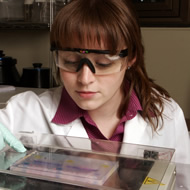
Environmental Factor, January 2009, National Institute of Environmental Health Sciences
2008 ONES Awardees Speak at NIEHS
By Eddy Ball
January 2009
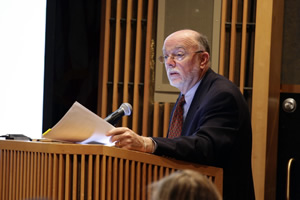
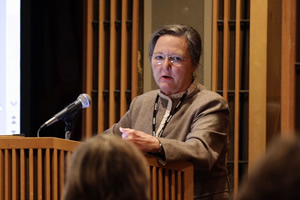
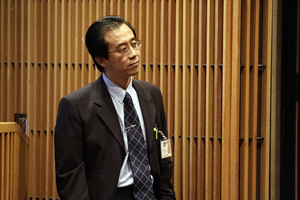
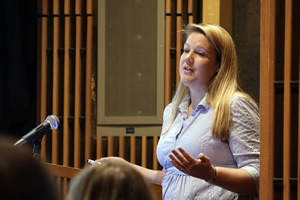
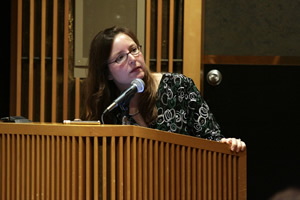
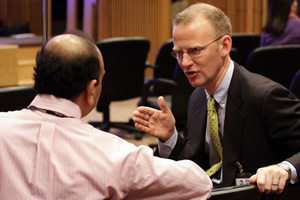
The 2008 winners of the Outstanding New Environmental Scientists (ONES) awards gathered in Rodbell Auditorium December 11 for their first group visit to NIEHS and presentations to Institute scientists. The young investigators were welcomed by NIEHS Acting Deputy Director Bill Suk, Ph.D., who described the event as “a proud day for DERT [Division of Extramural Research and Training].” Suk also called attention to incoming NIEHS Director Linda Birnbaum, Ph.D., who was in the audience.
The ONES winners are a diverse group, with specialized research interests in epidemiology, toxicology, biology and chemistry, who share a common goal of establishing themselves as independent principal investigators. Their research ranges across what Suk described as the NIEHS “rainbow” from fundamental research in molecular toxicology to the application of their findings for the prevention and treatment of disease.
In her opening remarks, ONES Program Director and meeting chair Carol Shreffler, Ph.D., explained that the ONES grants are R01 awards specially designed to help junior investigators at the start of their careers “put in the foundation for a successful research career.” The grants fund five years of research at $250,000 per year and support equipment purchases and career enhancement activities with an additional $150,000 during each of the first two years.
“This award is intended to be highly selective for the most talented scientists,” Shreffler continued. “We only allow one application per school within an institution.” There are also several other requirements that limit the pool of applicants, such as time since earning a Ph.D., tenure-track status, substantial institutional support, a commitment to spending 80 percent of their time on research, and a rigorous peer review process.
"We indeed have made this a very competitive process," she concluded, "and we look forward to having these awardees make some very seminal contributions to the future of our Institute."
The new ONES winners include six outstanding junior investigators:
- University of Michigan epidemiologist Marie Sylvia O’Neill, Ph.D., who is studying the exposures of pregnant women to air pollution in Mexico City and the link to preterm births through in vitro and in vivo studies of inflammatory response to air pollutants
- Duke University pulmonary and critical care physician John Hollingsworth, M.D., whose goal is to better understand the role of innate immunity in environmental airway disease and how exposure to ambient ozone can modify subsequent innate adaptive responses in the lung
- Hamner Institutes for Health Sciences physician-scientist Jingbo Pi, M.D., Ph.D., who seeks to elucidate the paradoxical roles of transcription factor Nrf2-mediated response to antioxidants in type 2 diabetes caused by arsenic exposure as the foundation for developing more effective preventive measures and therapies
- Duke University chemist Heather Stapleton, Ph.D., who will continue her investigation into the extent to which children are exposed to polybrominated diphenyl ethers (PBDEs) — flame-retardant chemicals that are present in indoor air and dust — and their link to thyroid dysfunction
- University of Rhode Island pharmacologist/toxicologist Angela Slitt, Ph.D., who plans to use her grant to explore how the expression of drug transporters affect chemical disposition and toxicity, and the ways nutrition and intake of dietary antioxidants affect the process
- Vanderbilt University neurobiologist Aaron Bowman, Ph.D., who seeks to characterize the gene-environment interaction between Huntington's Disease and manganese exposure, which may account for significant differences in the points at which the genetic condition manifests in different individuals
The morning presentations were part of a day-long agenda for the awardees that included lunch with DERT staff, and afternoon meetings with intramural scientists and postdoctoral fellows. The ONES awardees will make additional presentations at NIEHS over the course of their grants.
"NTP Unveils New Non-Cancer Study Criteria..." - previous story ![]()
![]() next story - "Global Health Meeting Highlights International Partnerships..."
next story - "Global Health Meeting Highlights International Partnerships..."
January 2009 Cover Page
